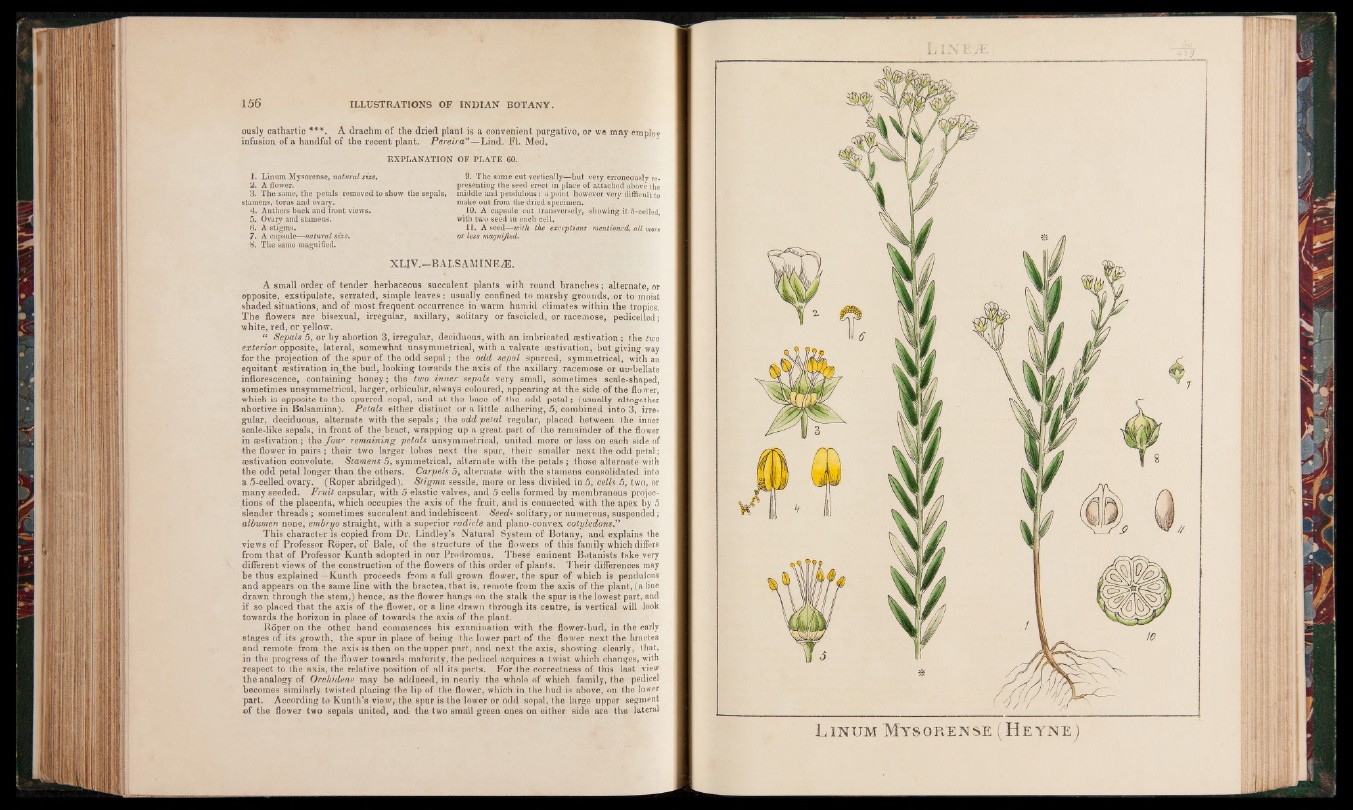
ously cathartic ***. A drachm of the dried plant is a convenient purgative, or we may employ
infusion of a handful of the recent plant. Pereiraw—Lind. FI. Med.
EXPLANATION OF PLATE 60.
1. Linum Mysorense, natural size,
2. A flower.
3. The same, the petals removed to show the sepals,
stamens, torus and ovary.
4. Anthers back and front views.
5. Ovary and stamens.
6. A stigma.
7. A capsule—natural size.
S. The same magnified.
9. The same cut vertically—but very erroneously representing
the seed erect in place of attached above the
middle and pendulous: a point however very difficult to
make put from the dried specimen.
10. A capsule cut transversely, showing it-5-celled
with two seed in each cell.
11. A seed—with the exceptions mentioned, all more
or less magnified.
XLIY.—BALSAMINEÆ.
A small order of tender herbaceous succulent plants with round branches; alternate, or
opposite, exstipulate, serrated, simple leaves: usually confined to marshy grounds, or to moist
shaded situations, and of most frequent occurrence in warm humid climates within the tropics.
The flowers are bisexual, irregular, axillary, solitary or fascicled, or racemose, pedicelled;
white, red, or yellow.
“ Sepals 5, or by abortion 3, irregular, deciduous, with an imbricated aestivation ; the two
exterior opposite, lateral, somewhat unsymmetrical, with a valvate aestivation, but giving way
for the projection of the spur of the odd sepal; the odd sepal spurred, symmetrical, with an
equitant aestivation in^the bud, looking towards the axis of the axillary racemose or umbellate
inflorescence, containing honey; the two inner sepals very small, sometimes scale-shaped,
sometimes unsymmetrical, larger, orbicular, always coloured, appearing at the side of the flower,
which is opposite to the spurred sepal, and at the base of the odd petal; (usually altogether
abortive in Balsamina). Petals either distinct or a little adhering, 5, combined into 3, irregular,
deciduous, alternate with the sepals; the odd petal regular, placed between the inner
scale-like sepals, in front of the bract, wrapping up- 1 great part of the remainder of the flower
in aestivation; the four remaining petals unsymmetrical, united more or less on each side of
the flower in pairs; their two larger lobes next the spur, their smaller next the odd petal;
aestivation convolute. Stamens 5, symmetrical, alternate with the petals ; those alternate with
the odd petal longer than the others. Carpels 5, alternate with the stamens consolidated into
a 5-celled ovary. (Roper abridged). Stigma sessile, more or less divided in 5, cells 5, two, or
many seeded. Fruit capsular, with 5 elastic valves, and 5 cells formed by membranous projections
of the placenta, which occupies the axis of the fruit, and is connected with the apex by 5
slender threads; sometimes succulent and indehiscent. Seeds solitary, or numerous, suspended;
albumen none, embryo straight, with a superior radicle and plano-convex cotyledons.”
This character is copied from Dr. Lindley’s Natural System of Botany, and explains the
views of Professor Roper, of Bale, of the structure of the flowers of this family which differs
from that of Professor Kunth adopted in our Prodromus. These eminent Botanists take very
different views of the construction of the flowers of this order of plants. Their differences may
be thus explained - Kunth proceeds from a full grown flower, the spur of which is pendulous
and appears on the same line with the bractea, that is, remote from the axis of the plant, (a line
drawn through the stem,) hence, as the flower hangs on the stalk the spur is the lowest part, and
if so placed that the axis of the flower, or a line drawn through its centre, is vertical will look
towards the horizon in place of towards the axis of the plant.
Roper on the other hand commences his examination with the flower-bud, in the early
stages of its growth, the spur in place of being the lower part of the flower next the bractea
and remote from the axis is then on the upper part, and next the axis, showing clearly, that,
in the progress of the flower towards maturity, the pedicel acquires a twist which changes, with
respect to the axis, the relative position of all its parts. For the correctness of this last view
the analogy of Orchideae may be adduced, in nearly the whole of which family, the pedicel
becomes similarly twisted placing the lip of the flower, which in the bud is above, on the lower
part. According to Kunth’s view, the spur is the lower or odd sepal, the large upper segment
of the flower two sepals united, and the two small green ones on either side are the lateral